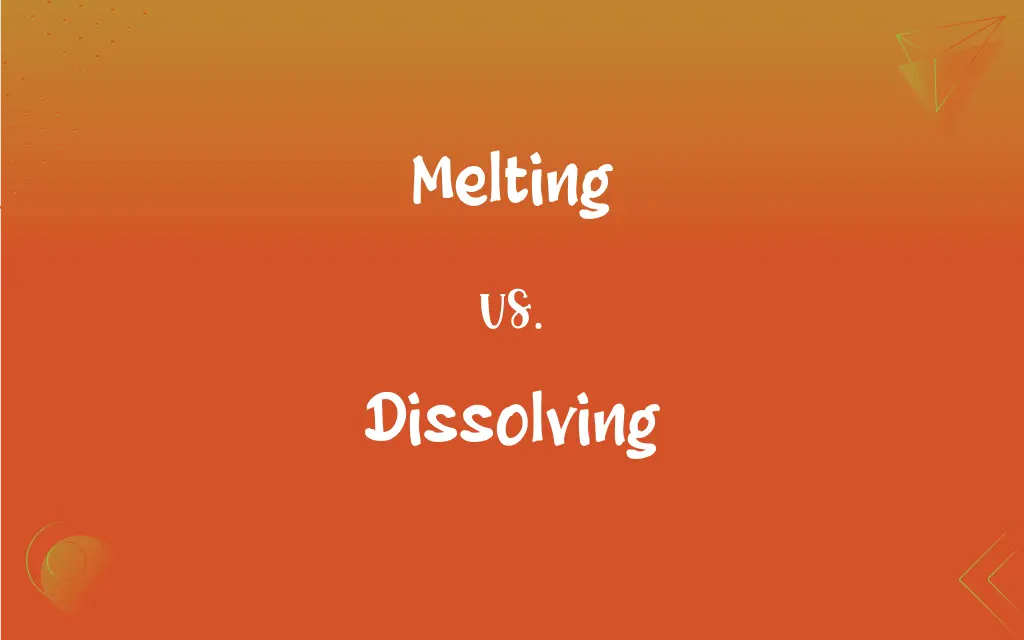Melting vs. Dissolving: What's the Difference?
Edited by Aimie Carlson || By Janet White || Published on November 23, 2023
Melting is the process of a solid turning into a liquid due to heat, while dissolving is a process where a substance becomes incorporated into a liquid to form a solution.

Key Differences
Melting is a physical change where a solid becomes a liquid due to heat application, as seen when ice turns into water. Dissolving, on the other hand, involves a solute (like salt) becoming incorporated into a solvent (like water), creating a solution without a change in physical state. While melting requires heat to break the bonds holding the solid structure, dissolving involves the interaction of the solute and solvent at a molecular level, creating a homogeneous mixture.
In melting, the primary interaction is between the molecules of the substance itself, where added energy (heat) weakens the bonds, leading to a change in state. Dissolving, however, involves interactions between two different substances – the solute and the solvent. This process can either absorb or release energy, depending on the nature of the substances involved. In melting, the identity of the substance remains unchanged, whereas dissolving leads to a mixture where the original form of the solute is no longer visible.
Melting is generally a reversible process, as the substance can return to its solid state upon cooling, like melted wax solidifying again. Dissolving can be reversible or irreversible, depending on the solute-solvent combination. For instance, salt can be recovered from saltwater through evaporation, but not all dissolved substances can be easily separated from their solvents. Both processes, however, do not lead to new substances; they merely change the form or dispersion of the original materials.
Melting is a critical process in industries like metallurgy and chocolate production, where controlling the melting point is crucial for product quality. Dissolving is equally significant in fields like pharmaceuticals, where the dissolution of drugs into bodily fluids affects their efficacy. In daily life, melting is observed in cooking, like butter on a hot pan, and dissolving is seen when making coffee or tea. Both processes are integral to various scientific, industrial, and everyday activities, each with its unique set of principles and applications.
Melting involves a phase change from solid to liquid, a transition that occurs at a specific temperature for pure substances, known as the melting point. Dissolving, however, does not entail a phase change; instead, it involves the dispersion of one substance within another, often leading to the creation of a solution. The process of melting is solely dependent on the nature of the substance and external temperature, whereas dissolving also depends on the properties of both the solute and the solvent, such as polarity and temperature.
ADVERTISEMENT
Comparison Chart
Phase Change
Solid to liquid
Solid, liquid, or gas into another liquid
Key Factor
Heat, reaching melting point
Interaction between solute and solvent molecules
Change in Composition
No chemical change, retains composition
Composition changes, forming a solution
Reversibility
Generally reversible (freezing)
Can be reversible or irreversible
Physical/Chemical Change
Physical change only
Physical change, formation of a homogeneous mixture
ADVERTISEMENT
Melting and Dissolving Definitions
Melting
Melting is the process of a solid turning into a liquid.
Ice cream left outside on a hot day began melting quickly.
Dissolving
Dissolving is the process of a substance becoming incorporated into a liquid.
Sugar cubes started dissolving as soon as they hit the water.
Melting
In melting, intermolecular bonds in a solid weaken, causing a phase change.
The melting of glaciers is a concern in global warming studies.
Dissolving
Dissolving can create a homogeneous solution.
Dissolving dye in water resulted in a uniform color solution.
Melting
Melting occurs when a substance reaches its melting point.
The melting point of ice is 0°C or 32°F.
Dissolving
Dissolving is often a reversible physical process.
After dissolving, the substance can often be recovered through evaporation.
Melting
Melting is a physical change from a rigid structure to a fluid form.
Chocolate bars began melting in the summer heat.
Dissolving
In dissolving, the solute breaks into ions or molecules in the solvent.
The tablet began dissolving, dispersing medicine in the water.
Melting
Melting involves absorbing heat by a solid.
The metal started melting in the furnace.
Dissolving
Dissolving involves the dispersion of a solute in a solvent.
Salt dissolving in water is a common example used in chemistry.
Melting
To be changed from a solid to a liquid state especially by the application of heat.
Dissolving
To cause to pass into solution
Dissolve salt in water.
Melting
To dissolve
Sugar melts in water.
Dissolving
To reduce (solid matter) to liquid form; melt.
Melting
To disappear or vanish gradually as if by dissolving
The crowd melted away after the rally.
FAQs
Is melting a chemical change?
No, melting is a physical change.
What factors affect dissolving?
Temperature, solvent type, and stirring can affect the dissolving process.
Can dissolving be a chemical change?
Dissolving is usually a physical change, but it can be chemical in some reactions.
How is saturation related to dissolving?
Saturation occurs when a solvent can no longer dissolve more of a solute.
What is a solute in dissolving?
A solute is the substance that dissolves in a solvent to form a solution.
Is melting reversible?
Yes, by freezing, the process can be reversed.
What is the melting point?
The melting point is the temperature at which a solid turns into a liquid.
Can all solids melt?
Most solids can melt, but some may decompose before melting.
Does pressure affect melting?
Yes, pressure can influence the melting point of substances.
What is sublimation in the context of melting?
Sublimation is when a solid turns directly into a gas without becoming a liquid.
Can dissolving be endothermic?
Yes, some dissolving processes absorb heat, making them endothermic.
What is an example of melting in daily life?
Ice melting into water is a common example.
What is a universal solvent in dissolving?
Water is often called a universal solvent due to its ability to dissolve many substances.
What is a supersaturated solution?
A supersaturated solution contains more dissolved solute than it would under normal circumstances.
How does melting relate to the state of matter?
Melting transitions a substance from solid to liquid state.
What is an immiscible solution in dissolving?
In an immiscible solution, the solute and solvent do not form a homogeneous mixture.
How does temperature affect dissolving speed?
Generally, higher temperatures increase the rate of dissolving.
Is there a limit to how much a solvent can dissolve?
Yes, once the saturation point is reached, no more solute can dissolve.
Do all substances have the same melting point?
No, different substances have different melting points.
Why do some substances not dissolve in water?
Some substances do not dissolve in water due to their molecular structure and polarity.
About Author
Written by
Janet WhiteJanet White has been an esteemed writer and blogger for Difference Wiki. Holding a Master's degree in Science and Medical Journalism from the prestigious Boston University, she has consistently demonstrated her expertise and passion for her field. When she's not immersed in her work, Janet relishes her time exercising, delving into a good book, and cherishing moments with friends and family.
Edited by
Aimie CarlsonAimie Carlson, holding a master's degree in English literature, is a fervent English language enthusiast. She lends her writing talents to Difference Wiki, a prominent website that specializes in comparisons, offering readers insightful analyses that both captivate and inform.

































































